- Home
- Craft Projects
- DIY Resin Jewelry
Resin Jewelry Making Guide for Beginners
DIY great resin jewelry with this complete, 15 step tutorial. Learn how to choose the best jewelry resin for your project, mix & pour in molds or bezels, prepare & add decorative fillers, sand & polish your items, and get tips to prevent & solve problems.
It can take some trial and error to get the techniques just right. But once you've experimented with a few batches of jewelry resin, you'll be amazed by all of the fun things you can make with a few simple tools and supplies.
How to Make Resin Jewelry
Choosing the best resin for your craft project is essential for success. Before we dive into the resin jewelry making instructions, we'll take a quick look at the types of resin you can use.
Types of Jewelry Resin
When you start looking for resin for craft projects, there are four major types you're likely to encounter:
- Epoxy coating resin
- Epoxy casting resin
- Polyurethane casting resin
- Polyester casting resin
Each type is best suited to different projects.
Use it for projects that need a thin layer of resin, like filling a bezel cup. It's fairly viscous (thick) and can be used to create a domed effect.
Use it for creating three dimensional items that aren't too big, such as filling a jewelry mold. It's less viscous and less prone to forming air bubbles.
Use it to cast three dimensional items that are too large to cast with epoxy resin. Also, consider using it for casting molds that have intricate details.
Polyester casting resin:
Polyester resin is used to cast larger molds with glass-like clarity. However, it is much more difficult to use safely and effectively compared with other types of resin.
I stick with epoxy resin or polyurethane resin, which should meet your needs well if you're making resin jewelry.
You can learn more about the best resin for your DIY projects and other supplies you'll need to get started in my comprehensive jewelry resin guide.
I earn a commission for purchases made through links on this page.
To learn more, please see my disclosure.
How to Make Resin Jewelry
15-Step Tutorial
Please don't be overwhelmed that there are so many steps described here. You won't actually have to do every step for every piece of resin jewelry you make.
There are several different ways to use resin to make your own jewelry. Some of the steps in the list only apply to certain types of resin projects.
Any step marked "optional" will be required in some projects but not others. Any step that's not marked "optional" describes something you'll typically need to do no matter what technique you're using.
- Protect yourself and your work surface
- Decide what you'll use to shape your resin
- Choose and prepare your design elements
- If you're using molds, spray them with mold release
- Certain embellishments go in your mold or bezel now (optional)
- Carefully measure and mix your resin and catalyst
- Add color and/or glitter to your mixed resin (optional)
- Pour your resin into molds or bezels
- Remove air bubbles
- Certain embellishments can go in your mold or bezel after you've poured the resin (optional)
- Cover your resin jewelry while it dries
- If you've used a mold, remove your hardened resin from the mold
- Drill a hole (optional)
- Sand rough edges (optional)
- Polish your resin jewelry (optional)
1. Protect yourself and your work surface
Protect Yourself
Check out the Safety Data Sheet (SDS) for the jewelry resin you're using. It should be posted on the manufacturer's website, and it will tell you everything you need to know to work safely.
In general, you'll need to use: latex gloves to protect your hands, safety goggles to protect your eyes, and a respirator designed for fumes.
Protect Your Work Surface
Resin spilled on furniture can result in a huge mess. Unfortunately, I know from experience.
Cover your work surface with a plastic garbage bag, plastic drop cloth or parchment paper. If you prefer to avoid waste, a silicone mat for crafts is a smart option for protecting your work surface.
Also, be sure to wear old clothes, so you don't ruin your favorite outfit. My rule is: if I would be heartbroken if it were ruined, I keep it away from my DIY resin jewelry projects.
If you'd like more information, check out my Jewelry Resin Guide linked above for more details about protective equipment to use while making resin jewelry.
2. Decide what you'll use to shape your resin
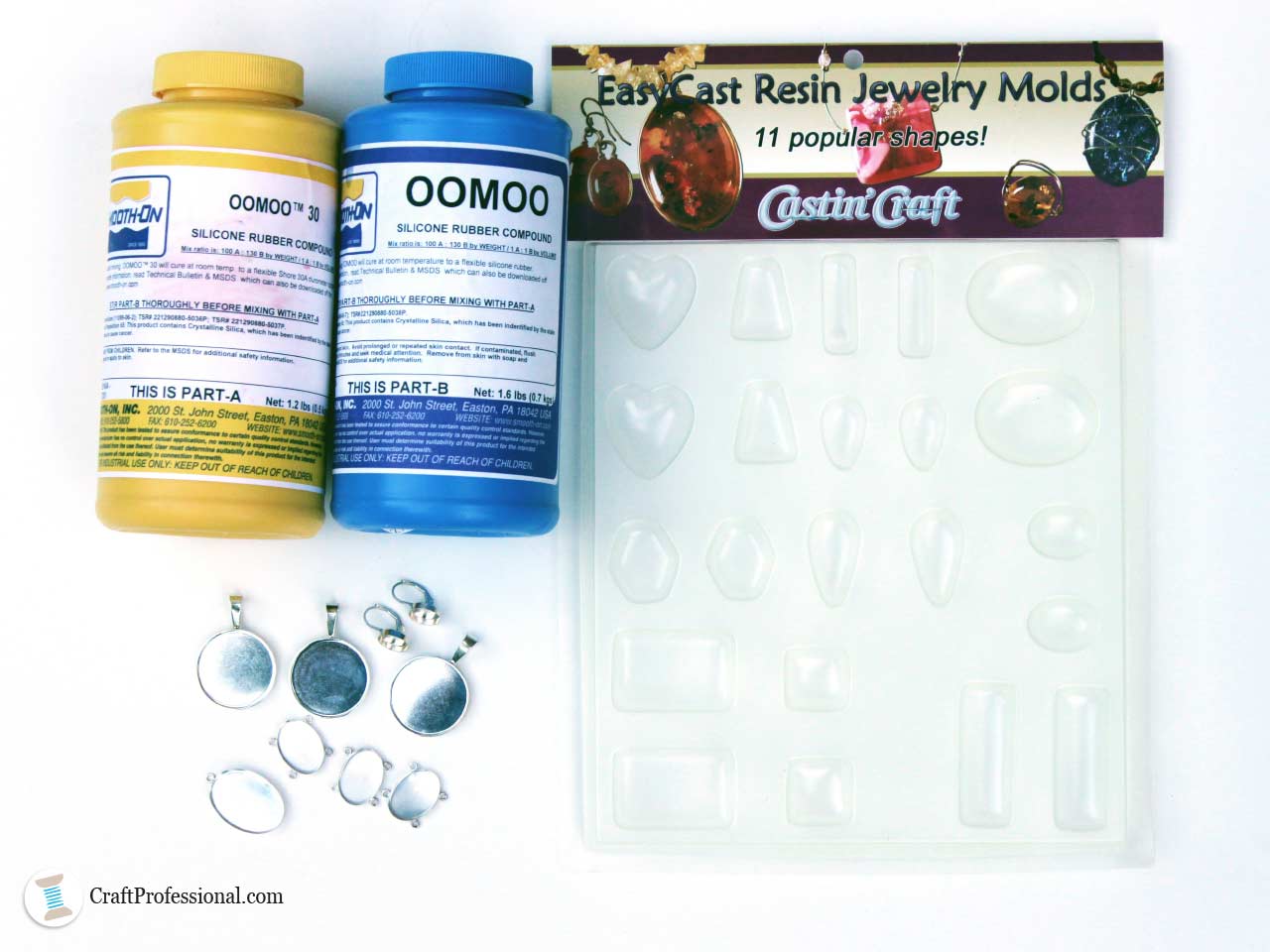 Three ways to cast resin jewelry: Commercial jewelry molds, bezels, or DIY your own silicone mold.
Three ways to cast resin jewelry: Commercial jewelry molds, bezels, or DIY your own silicone mold.You need something to contain the liquid resin so it cures into the shape you want. This choice will have a huge impact on your design and the techniques you'll use.
You can make beautiful resin jewelry using:
- closed back bezel trays - Easy to use and a good place for beginners to start.
- open back bezels - Slightly more complex to use because you need to take some extra steps to prevent the resin from seeping out of the bezel as it dries.
- commercially made resin jewelry molds - Casting jewelry pieces in commercial resin molds can involve simple projects or more advanced creations depending on the type of mold you use.
- a unique mold you DIY with a silicone mold-making compound - A more advanced technique because you'll need to learn how to make silicone molds, but it opens up a whole new world of jewelry making options.
3. Choose and prepare your design elements
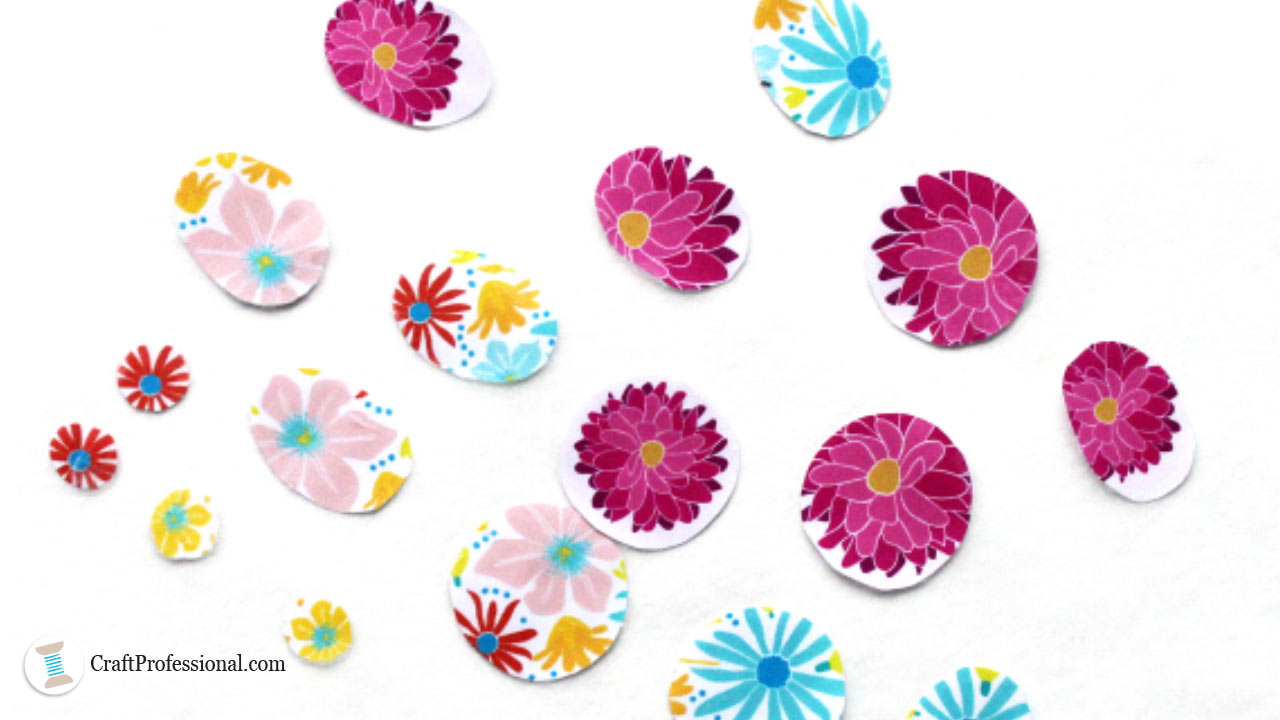 Patterned paper cut to fit bezels and sealed with Modpodge.
Patterned paper cut to fit bezels and sealed with Modpodge.Once you start to mix your resin, you need to work efficiently. That's why you must choose and prepare any design elements before you start working with resin.
If you're adding porous material like scrapbook paper to your handmade resin jewelry, you'll need to cut the paper to size and coat it front and back with a sealant such as ModPodge. Plan ahead because the sealant must be completely dry before you add resin.
4. If you're using molds, spray them with mold release (optional)
 Resin necklace made without a bezel
Resin necklace made without a bezelIf you're using bezels, skip ahead to step 5.
If you're casting resin in molds, first, ensure the molds are perfectly clean. Tiny bits of dust in a mold will show up as flaws in your cast resin.
Next, spray the mold with mold release to help the resin items pop out more easily once they are cured. Let the mold release dry.
If you're using bezels instead of molds, do not spray the bezels with mold release. The purpose of mold release is to help the piece easily pop out of the molds, you do not want the resin to pop out if you are using bezels!
5. Certain embellishments go in your mold or bezel now (optional)
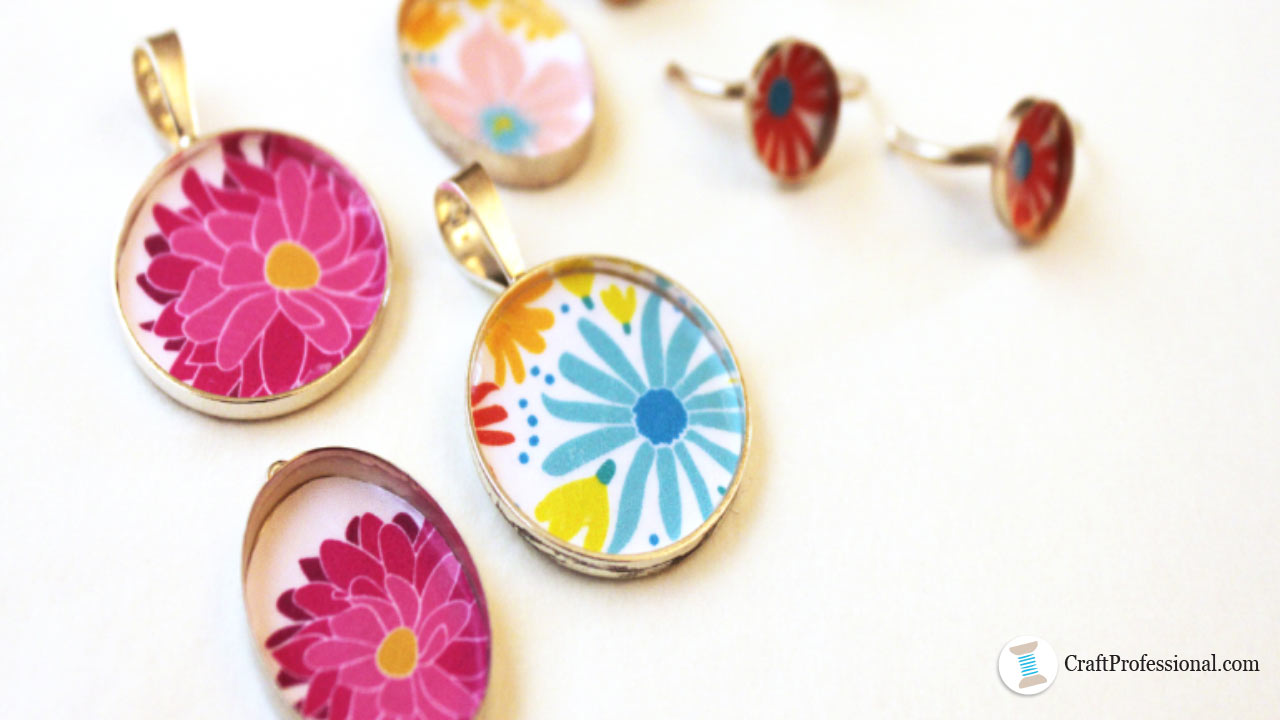 Sealed paper set into bezel trays
Sealed paper set into bezel traysSome design elements can be placed before you mix and pour your resin.
For example, if you're embedding paper images in bezels, you can set your paper image in each bezel at this stage.
Make sure you've coated your paper with a sealant - I use Mod Podge . And make sure the sealant has completely dried before you use it in a resin jewelry project
Press the paper firmly to the bottom of the bezel. Ensure it is flat, it completely covers the bottom of the bezel, and the design is oriented the way you want it.
6. Carefully measure and mix your resin and catalyst
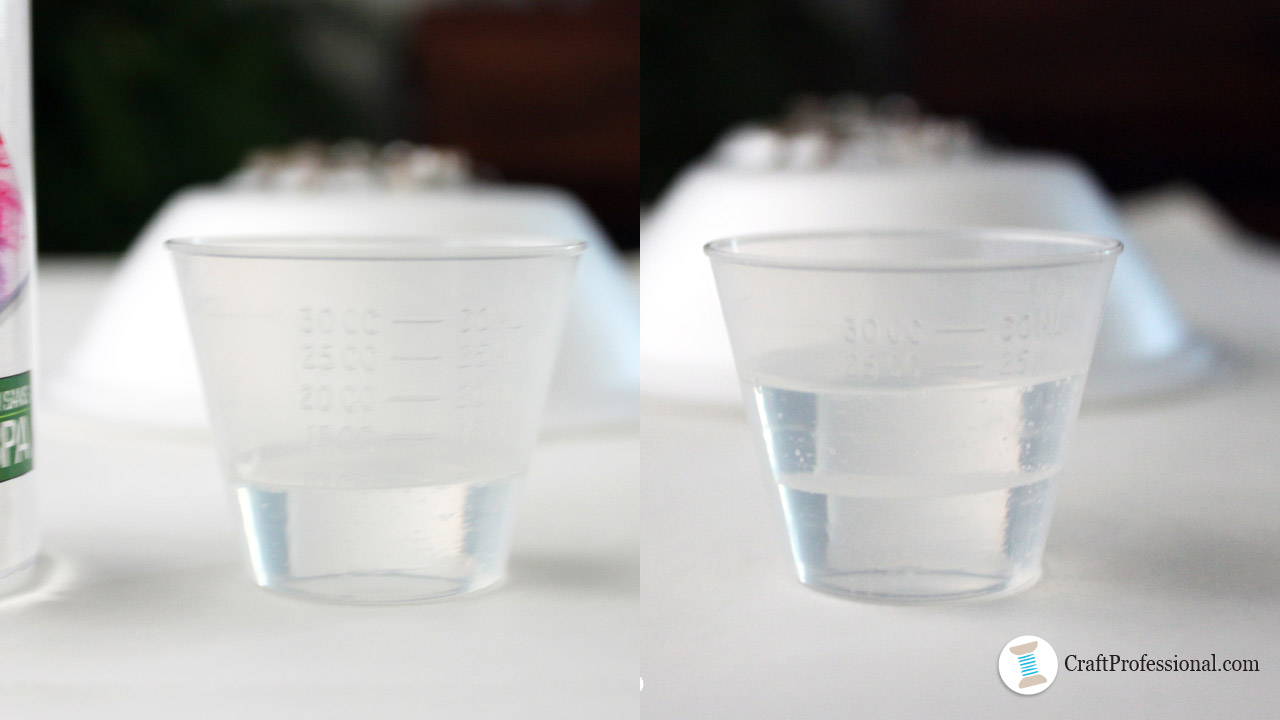 Left: Resin measured in a graduated medicine cup. Right: Equal amount of hardener poured into the same medicine cup.
Left: Resin measured in a graduated medicine cup. Right: Equal amount of hardener poured into the same medicine cup.Epoxy resin and polyurethane resin come in two parts - resin and hardener (catalyst) - that need to be measured accurately and stirred carefully.
I use small graduated medicine cups to measure and craft sticks mix. Graduated medicine cups are inexpensive and allow you to accurately measure for small batches.
Pour the resin and the catalyst into a medicine cup in the proportions specified on the package.
How to Measure Resin Accurately
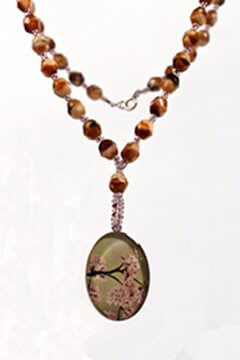 Necklace made with a bezel
Necklace made with a bezelIf you wanted to make one ounce of resin using a product that was mixed using equal parts resin and catalyst, first you'd pour one half ounce of resin into the medicine cup.
Bend down until the cup is at eye level so you can measure more accurately. Accuracy is key in successfully making resin jewelry.
Next, pour one half ounce of catalyst into the same measuring cup. The cup will already contain one half ounce of resin, so you'll add the catalyst until the mixture reaches the one ounce mark.
Now you have one half ounce of resin and one half ounce of catalyst in the same medicine cup.
Measuring each component in the same cup is much more accurate than measuring them in separate mixing cups. If you measure in separate cups, you'll then have to pour one component into the other and you'll lose some of the poured component as it sticks to the sides of the original cup.
How to Mix Jewelry Resin
Stir slowly with a clean craft stick for two minutes. Do not stir fast, or you'll create air bubbles, which are difficult to get rid of and will ruin the look of your jewelry (unless you want air bubbles as an effect).
Be careful to scrape the popsicle stick along the edges and bottom of the cup so everything is well mixed.
Slowly pour your mixture into another medicine cup and stir a little bit more. This step will ensure everything is well mixed and will eliminate any chance that resin sticking to the sides of the first cup did not get mixed.
7. Add color and/or glitter to your mixed resin (optional)
Here's another stage at which you can add embellishments to your resin jewelry. This time - if you choose - you'll be adding pigment or a bit of glitter to your resin.
Instructions vary depending on the type and brand you're using, so carefully follow the manufacturer's instructions for adding different colors or glitter.
Be aware that adding too much extra liquid to your resin mixture can prevent it from curing properly. Don't add too much liquid colorant to your jewelry resin.
8. Pour your resin into molds or bezels
You need to work efficiently but methodically here. You have a limited amount of time to work with your jewelry resin before it starts to thicken, so don't dilly-dally!
Carefully pour the resin into the bezels or molds you're using.
If you're using doming resin in bezels, you can create an attractive domed effect by carefully pouring the resin so it rises just a bit above the lip of the bezel in a dome shape.
9. Remove air bubbles
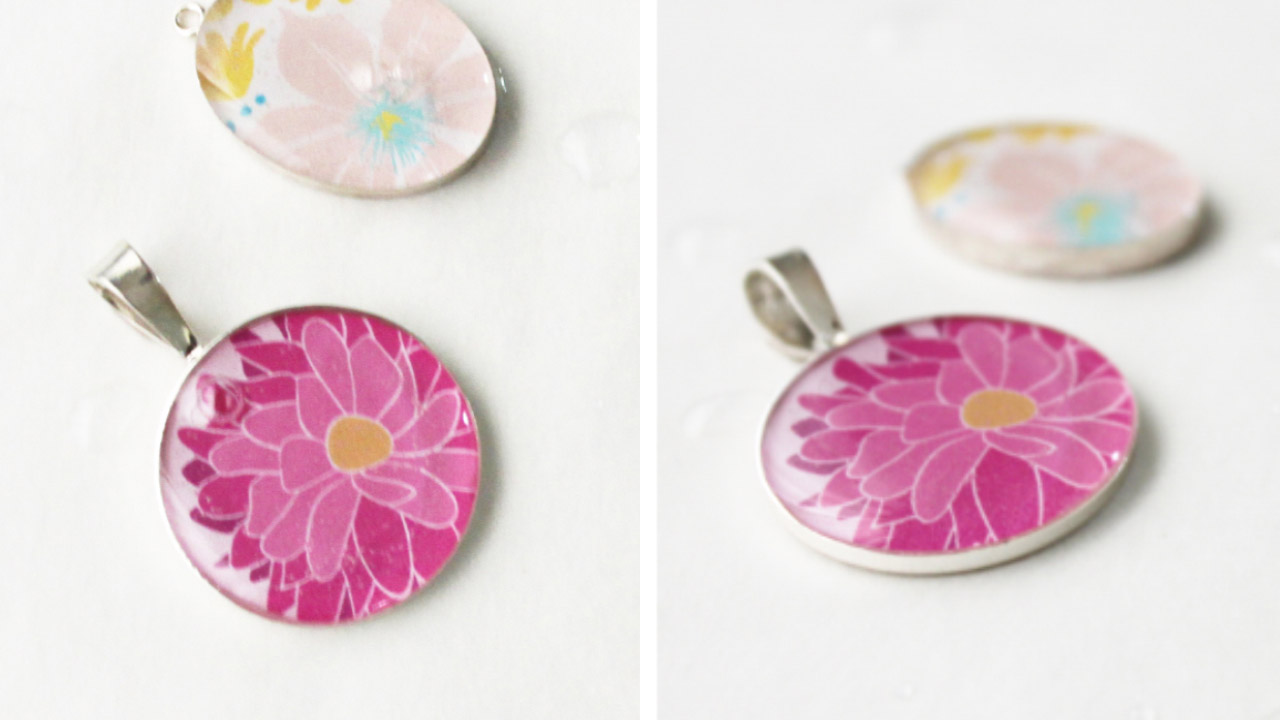 Left: Newly poured resin pendant with air bubbles. Right: Bubbles disappear when resin is warmed with a heat gun.
Left: Newly poured resin pendant with air bubbles. Right: Bubbles disappear when resin is warmed with a heat gun.The best cure for air bubbles is prevention. That's why it's so important to mix and pour your resin slowly. However, a few air bubbles are inevitable.
If you look around, you'll find plenty of tips for getting rid of air bubbles. I'm sure I've tried them all, and the tool I've found is an embossing heat gun.
Briefly hold the heat gun just above the resin, and you'll see tiny bubbles rise to the top and pop.
10. Certain embellishments can go in your mold or bezel after you've poured the resin (optional)
Here's another opportunity to add design elements to your resin.
Adding Small, Light Items to Resin
If you're including light items that will float, like small glitter or images printed on transparency paper, you can include them right away, you don't have to let the resin cure at all.
If you include an image on a transparency (some people also use shrink plastic), use a pair of tweezers to hold the transparency and dip it in the resin that's left over in the medicine cup. This extra step will help prevent air bubbles from forming between the poured resin and the transparency paper.
You may also need to pass a heat gun over this resin first to avoid air bubbles.
Place the transparency face down if you're using a mold or face up if you're using a bezel.
Adding 3D Items to Resin Jewelry
If you're adding small items to a mold - like a little plastic toy - you must pour your jewelry resin in layers.
Pour your first thin layer of resin, and give it some time to set.
Cover the small object you're embedding and then arrange it face down on the cured first layer. Pour more resin ensuring your item is completely covered in resin.
Get out your heat gun again to get rid of any bubbles in the second layer.
11. Cover your resin jewelry while it dries
Cover your items with a perfectly clean box to keep any dust from sticking to your uncured resin. Leave it undisturbed while it cures.
Follow the manufacturer's instructions for curing times. Generally, your pieces will be cured to the touch in 24 hours, but it takes several days to be fully cured.
12. If you've used a mold, remove your hardened resin from the mold
Follow the resin manufacturer's instructions for removing your resin from the mold.
Different types and brands of resin cure at different rates. You'll need to check the specific craft resin you're using to determine how long you need to leave the resin before demolding
If you've used mold release , you should be able to remove your resin with ease.
13. Drill a hole (optional)
If you want to drill a hole in your resin jewelry, you must use a hand drill .
Do not use a regular drill. Even set at a low speed, a power drill will generate too much heat and melt your resin jewelry.
14. Sand rough edges (optional)
If you'd like to sand your resin jewelry, you can start with more coarse sandpaper (100-180 grit) to sand out large-ish bumps (for example, if you want to smooth the edges of a piece that you have not set in a bezel).
Work your way down to finer grit (600-1500 grit) wet/dry sandpaper to finish the piece. You'll find fine grit wet/dry sandpaper in the automotive section of many department stores.
Sand your item underwater to reduce dust, and use gentle pressure.
Be aware that sanding your jewelry will turn the very clear finish into a more cloudy finish, so be certain that this effect is what you want before you start sanding.
15. Polish your resin jewelry (optional)
You can also polish up your work with a little bit of carnauba wax , which you can also find in the automotive section of hardware or department stores.
I use Mother's brand, which comes in a red bottle, but there are several brands to choose from. Simply cover the resin with a thin layer of carnauba wax. Let it dry for a few minutes, and then use a soft cloth to polish off the excess carnauba wax.
Resin Jewelry Making Supplies
Related: Detailed description of all the supplies you'll need for a resin jewelry project
- epoxy resin
- OR polyurethane casting resin
- plastic trash bag, drop cloth, parchment paper or silicone mat for crafts
- gloves
- safety goggles
- respirator - Check the Safety Data Sheet for the resin you're using to find specific safety instructions.
- bezel trays
- OR resin jewelry molds
- craft sticks
- graduated medicine cups
- mold release - Only necessary if you're using molds to make your resin jewelry
- heat gun
- pigment (optional)
- 3D charms (optional)
- sealant - Only required if you're using items that need to be sealed)
Resin Jewelry Videos
Since it can be helpful to see a process in action, I've included a series of videos that shows the process of making resin jewelry (just scroll down a bit). The music in the videos may start to grate on you a bit, but the instructions are detailed and excellent.
There are a few things you may want to do a bit differently than the videos suggest:
1. A fairly big batch of resin is mixed in the video. I like working with smaller batches so it doesn't start to set before I'm finished.
If you're new to making resin jewelry, you won't be very efficient the first few times you try it. If your mixture starts to set before you're finished pouring, you can get funny swirls and lines, so smaller batches are often better. You can always mix more if you need to, but if you mix too much and it sets too soon, you'll end up wasting that resin.
2. Medicine cups are ideal for mixing small, manageable batches, and pouring the resin into a condiment bottle is not necessary if you're doing small batches.
3. The video recommends breathing through a straw or using a hair dryer to get rid of air bubbles. In my opinion a heat gun is a much better tool for getting rid of air bubbles.
I'd avoid using a hair dryer. The problem with hair dryers is that they blow air too forcefully and can easily blow your resin all over and cause messes or strange waves if it has started to thicken.
A heat gun expels warm air without forcefully blowing that air; it is a much safer and more effective way to get rid of air bubbles.
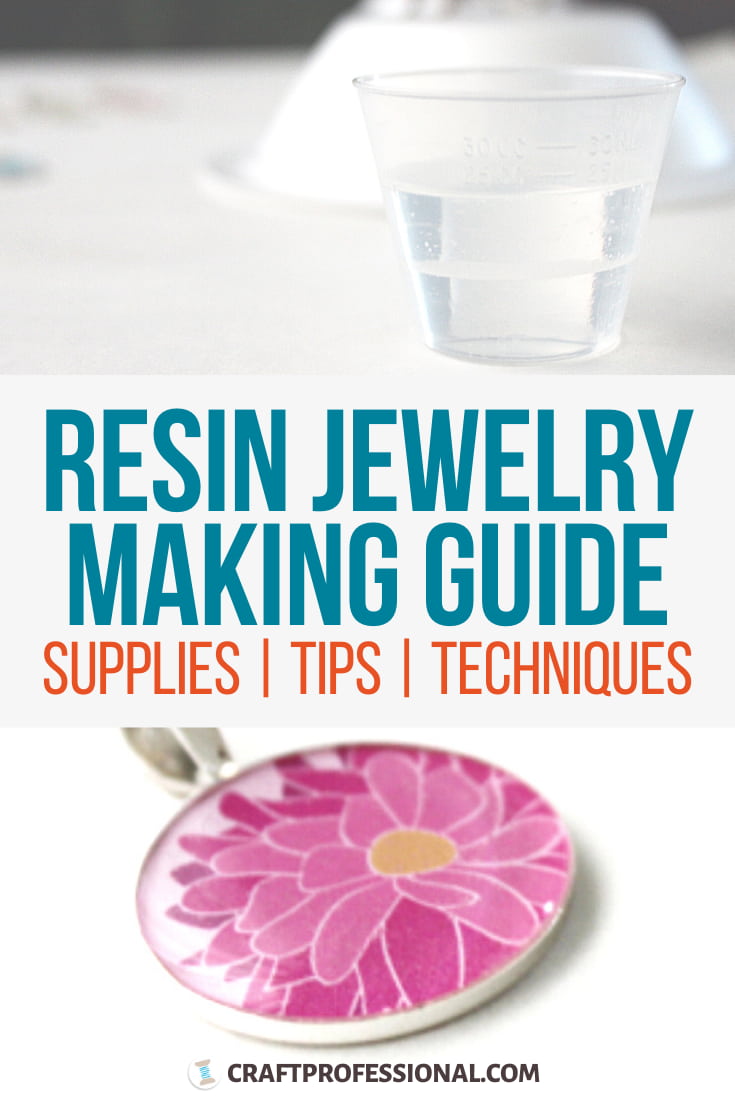


New! Comments
Have your say about what you just read! Leave me a comment in the box below.